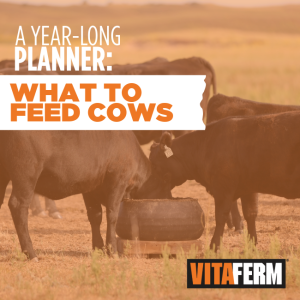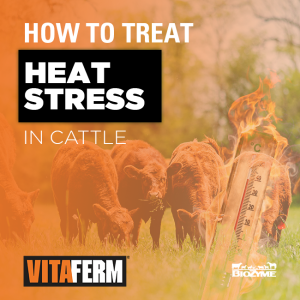As cattle producers, when the temperature rises, you begin to feel the pressure of keeping the herd healthy and efficient. The warmer it gets outside, the more your herd runs the risk of decreased performance, increased sickness and ultimately economic losses. And when you put yourself in the shoes of the stocker operator, this pressure is magnified as youtry to keep calves performing through their prime growth period.
What is heat stress?
The degree of heat stress is typically measured by a temperature-humidity index, or THI, and this threshold varies based on the production stage of the animal. For stockers the threshold THI for moderate stress is about 84-degrees, where it might be about 5 degrees lower for a lactating cow. The duration of extreme temperatures also plays a role in the way heat stress impacts stockers. Therefore, there is no one size fits all approach to solving the heat-stress challenges, and cattle operators should be adaptable and develop solutions based on their specific herds’ needs.
“The unfortunate part is everybody’s situation is different based on regional climate differences,” said Kevin Glaubius, Director of Nutrition for BioZyme® Inc. “Where a backgrounder in Texas might have to deal with severe heat for seven months, someone in North Dakota might have extreme heat for just two months. However, the commonality is understanding the cascade of events that go on with heat stress – symptoms to look for and what to do.”
How do you detect heat stress?
The first visible sign of heat stress you should look for is an increased respiration rate. The increase in respiration rate leads to increased air volume intake, which can ultimately lead to other sicknessesin the calves. With increased air intake, the calves are inhaling more dust, dirt, bacteria and viruses into their bodies, which can quickly lead to bigger problems.
The second sign of heat stress, and the one most commonly thought of, is calves that seek out shade and water during the peak heat of the day. This disrupts the normal feeding pattern of continuously grazing and consuming smaller meals. That disruption shifts to night grazing and slug feeding where they eat more at once due to increased hunger. Slug feeding leads to acidosis and bloat, which can lead to more health issues. When they bunch up during the day, they also are more likely to be exposed to sickness because of shared germs – think of containing school kids in an enclosed room with no fresh air.
How does heat stress effect gut health and gain?
“Metabolically, the cells are working harder, when the calves’ respiration increases, so those cells have to be replaced more often. Microbes have a life cycle of minutes – maybe 90 minutes – so disruption of eating during the day starves the microbes from their growth pattern, which is why this is a great time to introduce a prebiotic like Amaferm® into the calves’ diets,” Glaubius said.
Amaferm®️ is a prebiotic designed to enhance digestibility by amplifying the nutrient supply for maximum performance. It is research-proven to increase intake, digestion and absorption. Feeding Amaferm during heat stress has multiple benefits including improved digestibility, increased energy availability, improved rumen function and less loss of performance. The improved digestibility observed with Amaferm feeding provides more energy to the animal during heat stress when intake is reduced.
In ideal conditions, when heat stress isn’t a challenge, and voluntary feed intake exists, typically 70-percent of the diet goes toward maintenance while 30-percent will go to gain. During times of extreme heat, those numbers change, and 80-percent of intake goes toward maintenance, and only 20-percent goes to gain, costing the stocker operator lost performance over time. That’s why it is imperative to keep your calves as cool as possible and regulate their grazing habits, keeping them eating regularly and performing.
Tips to combat heat stress in your stockers:
- If you do need to work or treat any sick calves, do so early in the day when the temperatures are the coolest. Try to avoid stirring up large groups, causing unnecessary stress.
- Any physical exercise like moving calves from pasture to pasture, needs to be done in the early morning during the coolest part of the day.
- Provide adequate shade. If trees are available great. If you are feeding small groups of calves, consider portable shade options or build your own shade options if in pastures or lots you use each year.
- Provide cool, fresh water constantly. Water intake is directly correlated to feed intake. If your calves’only water source is a pond where the calves are bunching to stay cool, consider putting in a tank with fresh well water flow so the calves get fresh water that they haven’t stood in.
- Provide a high-quality vitamin and mineral supplement like VitaFerm®Gain Smart® Stocker HEAT® to keep the calves healthy, cooler and growing.
Raymond Fussell, who backgrounds calves at Tennessee Ridge, Tenn.,in the heart of stocker country, has been supplementing his yearlings with VitaFerm®Gain Smart®Stocker HEAT®for the past few years. Upon first trying the product, Fussell saw that not only were the calves healthier, but he also noticed a significant difference in their heat tolerance, growth and fly control when using the HEAT mineral.
“This year I only had three head that were so small they didn’t match. The other 132 averaged 901 pounds. I’ve been running pretty much the same cattle for 20 years on this place, and they have never averaged 900 nor had that few to sort off. With the better performance at home, and lower death loss during transport and the 48 hours following arrival, the extra cost over our previous mineral program was a good investment. These results were good enough that we will be feeding VitaFerm Gain Smart Stocker HEAT to all our steers the remainder of the summer and next year.”
Ideally suited for backgrounding and yearling cattle on grass, VitaFerm Gain Smart Stocker HEAT contains Capsaicin, research-proven to help maintain normal body temperature and support animal performance and gain in both heat and fescue situations. It also includes Amaferm which is shown by research to increase average daily gains, improve the variation in dry matter intake and improve both animal health and rumen health, and garlic, to deter insects.
“Research proves that with Amaferm in the diet, cattle producers typically see a quarter-pound of increased gain per day. Combine that with the HEAT mineral components, and that has the potential to increase to a half-pound per day,” Glaubius said.
Stocker operators face challenges and healthy gain in the summer is no easy feat, but it doesn’t have to be impossible. Establishing a good nutrition program and proactive management practices can help mitigate heat stress and its ability to wreak havoc on the herd.



